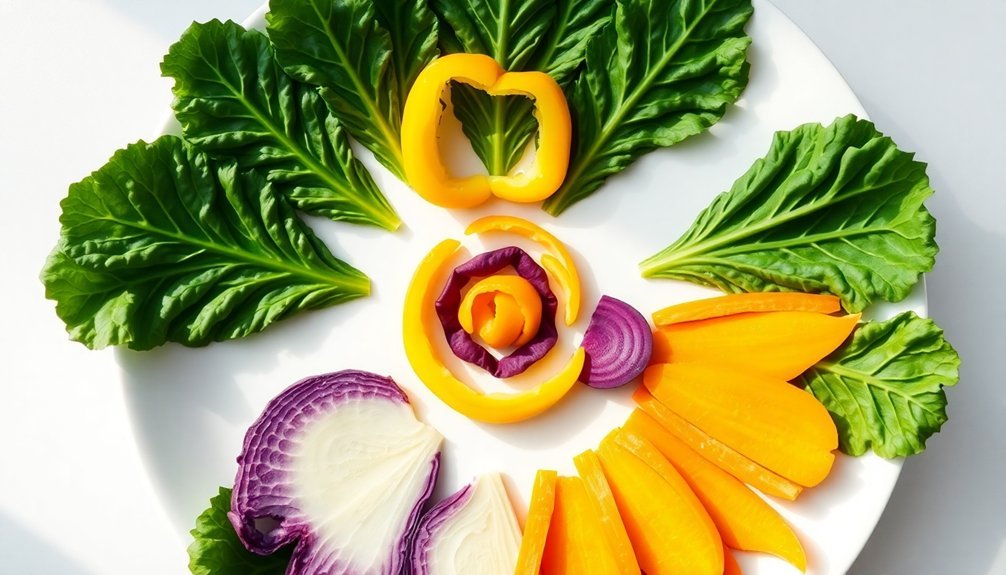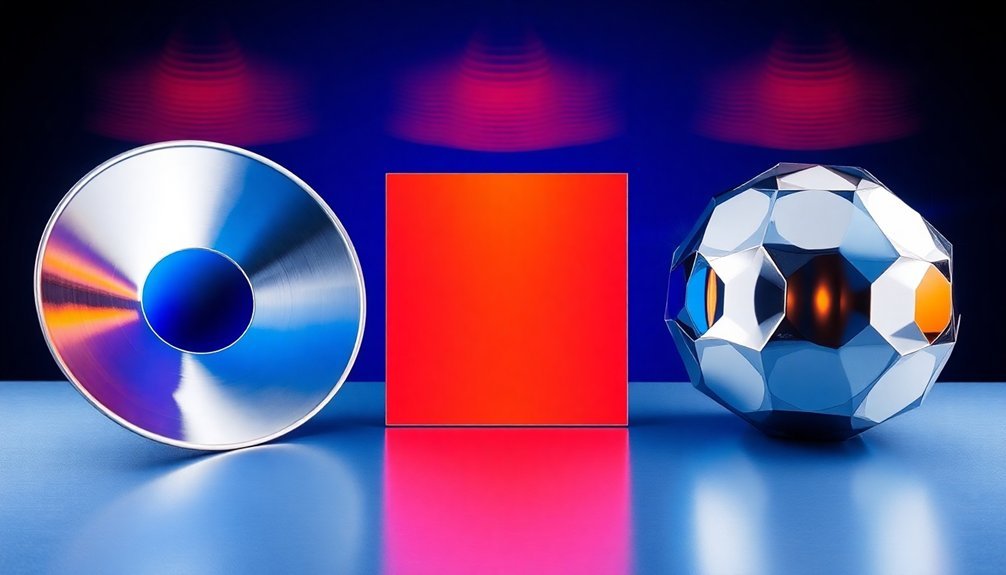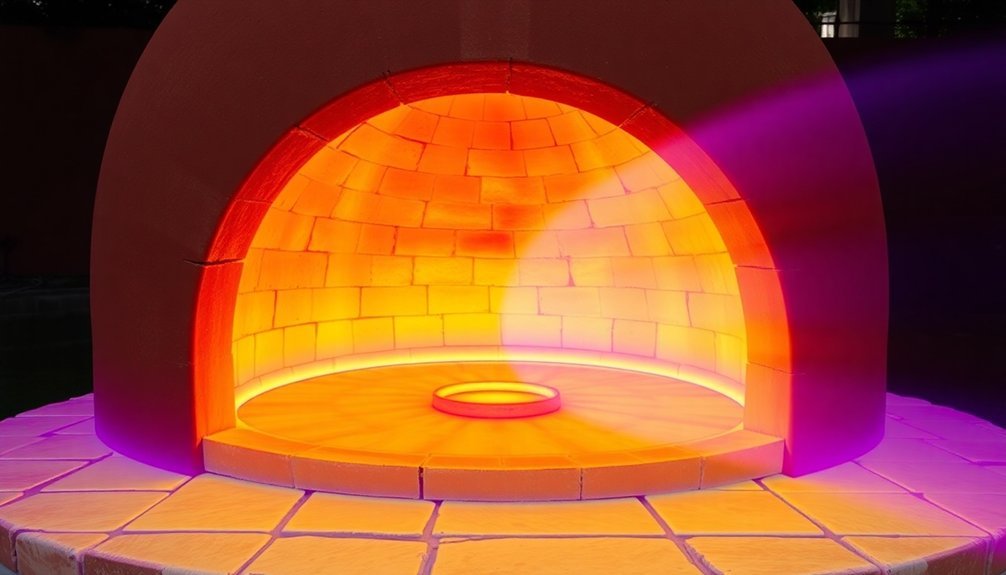For your outdoor cooker, you'll want to focus on aluminum or stainless steel baking pans. Aluminum offers excellent heat conduction and lightweight handling, while stainless steel provides superior durability and rust resistance. Choose light-colored pans for delicate items like cakes and pastries, but opt for darker pans when you need crispy crusts or browned surfaces. Look for heavy-gauge construction with at least 2 inches of clearance on all sides for proper heat circulation. Non-stick coatings can help, but ceramic-coated options last longer than traditional PTFE surfaces. Understanding the right pan materials and features will transform your outdoor cooking success.
Essential Outdoor Baking Pan Materials

Four primary materials dominate the outdoor baking pan landscape: aluminum, stainless steel, cast iron, and silicone. For outdoor cooking, you'll want to evaluate each material's unique properties carefully.
Cast iron stands out as an excellent choice for outdoor baking, offering superior heat retention and durability. While it's heavier, you'll benefit from its ability to create perfectly browned crusts.
Aluminum pans excel at heat conduction and won't weigh down your outdoor gear, though they're less suitable for acidic foods. For consistent baking results, consider using light-colored aluminum pans to prevent excess browning.
If you're looking for easy maintenance, stainless steel pans resist rust and clean up quickly, but they won't distribute heat as evenly.
Silicone offers flexibility and non-stick properties, but you'll need to adjust cooking times since it conducts heat poorly.
Dark Vs Light Pan Colors
When choosing baking pans for outdoor cooking, the color of your pan greatly impacts your results. Dark pans absorb heat more efficiently but can cause baked goods to brown too quickly or burn around the edges. You'll need to reduce your cooking temperature by 25 degrees when using dark pans. Light pans reflect heat and provide more even baking, making them ideal for delicate items. Using silicone baking mats can help distribute heat more evenly across your pans for better results.
| Item Type | Dark Pan | Light Pan |
|---|---|---|
| Pizza & Cornbread | Perfect Choice ✓ | Not Recommended |
| Cakes & Pastries | Requires Temp Adjustment | Ideal Choice ✓ |
| Roasted Vegetables | Best Results ✓ | Less Effective |
For outdoor cooking, select dark pans when you want crispy crusts and deep browning. Choose light pans when you're baking items that need gentle, even heat distribution. Remember to check dark pan recipes 10-15 minutes earlier than suggested cooking times.
Heat Distribution in Solar Ovens

Understanding heat distribution in solar ovens starts with their basic components: reflectors, absorbers, and insulation.
Dark-colored cast iron pots take significantly longer to heat compared to aluminum options.
You'll get the best results using aluminum pans, which quickly absorb heat and distribute it evenly throughout your food. While copper's also effective, it retains heat longer, making it ideal for cloudy conditions.
To maximize heat distribution, you'll want to position your reflectors to concentrate sunlight onto your cooking vessel. A 4-foot aluminum foil reflector can help you reach temperatures up to 300 degrees.
You can enhance heat retention by using materials like crumpled newspaper or water-filled soda cans as thermal mass. Remember, your oven's interior should either be black to absorb heat or shiny to reflect sunlight onto your cooking vessel.
Position your oven carefully, as placement considerably affects heat distribution.
Aluminum Pan Performance Benefits
The superior heat conductivity of aluminum pans makes them an exceptional choice for outdoor cooking. You'll notice faster heating times and more even heat distribution, which helps prevent hot spots and burned food while saving valuable fuel during your outdoor cooking adventures.
If you're considering aluminum pans, opt for hard-anodized versions. They're more durable, scratch-resistant, and won't react with acidic ingredients like tomatoes or citrus. The anodized coating creates a protective barrier that maintains food flavor integrity and reduces aluminum absorption.
You'll also appreciate the practical benefits. Aluminum pans are lightweight, making them easy to transport and handle at your campsite. They're more affordable than stainless steel or copper alternatives, and they don't require special maintenance like cast iron does.
These features make aluminum pans particularly well-suited for outdoor cooking scenarios.
Durable Materials for Outdoor Use

Selecting materials built to withstand outdoor conditions will considerably extend your baking pan's lifespan. When choosing pans for outdoor cooking, you'll want to focus on stainless steel and cast iron options. These materials excel in durability and heat management, making them ideal for varying outdoor temperatures.
| Material | Durability Feature | Best For |
|---|---|---|
| Stainless Steel | Rust-resistant | All-weather use |
| Cast Iron | Multi-decade lifespan | High-heat cooking |
| Ceramic | Impact-resistant | Even heat distribution |
While glass and porcelain pans offer excellent baking performance, they're less suitable for rugged outdoor environments due to potential breakage. Stainless steel won't react with acidic ingredients, and cast iron's seasoned surface improves with use. Both materials can handle the bumps and temperature fluctuations common in outdoor cooking settings.
Size and Shape Considerations
Beyond material selection, proper sizing and shaping of your outdoor baking pans will impact your cooking success.
You'll need to verify your pans have at least 2" clearance on all sides when placed in your outdoor cooker for maximum heat circulation.
Consider half-sheet pans (13" x 18") for versatility, but confirm they'll fit your specific cooker model.
For bread and desserts, choose pans with appropriate depth – round cake pans should be at least 2" deep, while loaf pans need sufficient space for dough expansion.
If you're planning to make specialty items, remember that Bundt pans require 8-12 cups capacity, and jelly roll pans need specific 10" x 15" dimensions.
Don't forget to account for handles or rolled edges when measuring your cooker's available space.
Heavy-Gauge Construction Features

Quality heavy-gauge construction stands at the forefront of outdoor baking success. You'll find that thicker pans with lower gauge numbers provide superior heat distribution and durability for your outdoor cooking adventures. When selecting your pan, look for reinforced rims with galvanized steel encapsulation to prevent warping at high temperatures.
| Feature | Benefit | Best For |
|---|---|---|
| Tri-ply Construction | Enhanced conductivity | Even baking |
| Flush Rivets | Secure build | Long-term use |
| Rolled Rims | Warp resistance | High heat |
| Heavy Gauge Steel | Consistent results | All-purpose |
| Encapsulated Layers | Better heat control | Delicate foods |
Your pan's construction directly impacts its performance, so you'll want to prioritize heavy-duty materials like hard-anodized aluminum or tri-ply stainless steel with an aluminum core for best results in your outdoor cooker.
Non-Stick Coatings for Solar Cooking
When choosing non-stick coatings for your solar cooking pans, you'll need to evaluate their durability under intense sun exposure and high temperatures.
Traditional non-stick surfaces aren't ideal for solar cooking, as they can degrade and affect heat distribution across your cookware.
You're better off selecting black enamel or specialized solar-safe coatings that maximize heat absorption while maintaining their integrity outdoors.
Non-Stick Durability Outdoors
Although solar cooking presents unique challenges for non-stick coatings, modern innovations in coating technology have made outdoor cooking more reliable than ever.
Sol-gel ceramic coatings offer superior durability for outdoor use, withstanding temperatures up to 550°F while resisting wear and abrasions better than traditional PTFE options.
You'll need to take special precautions when using your pans outdoors. Heat them gradually to prevent damage, and always use wood or silicone utensils to protect the coating.
If you're choosing between options, ceramic coatings typically last twice as long as comparable materials and don't contain PFAS compounds.
Remember to let your pans cool naturally before cleaning, as thermal shock can affect their longevity. For peak performance, stick to high smoke point oils and avoid cooking sprays, which can leave residue and compromise the non-stick surface.
Solar Heat Distribution Effects
Solar cooking requires a deep understanding of heat distribution to maximize your non-stick pan's performance.
When choosing a pan, you'll want to take into account how it interacts with different heat transfer mechanisms. Metal pans, especially those with black surfaces, conduct and distribute heat more efficiently than non-metallic alternatives, making them ideal for solar cooking.
- Your pan's material affects temperature retention – aluminum and stainless steel perform better than glass or ceramic in maintaining consistent heat.
- Dark-colored pans absorb more infrared radiation, which makes up 53% of sunlight.
- You'll get better results by placing a glass bowl inside your metal pan to enhance heat distribution.
- The pan's position matters – adjust it regularly to match the sun's angle for best heating.
Remember that even the best non-stick pan won't perform well without proper maintenance of your cooker's reflective surfaces.
Coating Material Selection Tips
Three key factors determine the success of non-stick coatings in solar cooking: color absorption, heat resistance, and safety. You'll want to select dark-colored coatings, as they absorb sunlight more efficiently and trap heat inside your cooker. When choosing a non-stick surface, opt for ceramic coatings that can withstand high temperatures without degrading or releasing harmful fumes.
| Feature | What to Look For | What to Avoid |
|---|---|---|
| Color | Dark or black surfaces | Light-colored finishes |
| Material | Ceramic non-stick | Standard Teflon |
| Safety | Food-grade coatings | Chemical-leaching surfaces |
| Maintenance | Scratch-resistant finish | Easily damaged coatings |
Remember to maintain your coated cookware properly by avoiding abrasive cleaners and using appropriate utensils to protect the non-stick surface. Glass cookware with dark, non-stick coatings offers an excellent combination of safety and efficiency.
Multi-Purpose Outdoor Baking Containers

Choosing the right multi-purpose container for outdoor baking can greatly enhance your cooking experience.
You'll find several materials that excel in outdoor settings, each offering unique benefits for your cooking needs.
- Anodized aluminum containers are your lightest option, featuring excellent heat distribution and easy cleanup – perfect for frequent outdoor cooks who value portability.
- Cast iron's exceptional heat retention makes it ideal for consistent results, though you'll need to take into account its weight when transporting.
- Stainless steel offers worry-free maintenance and rust resistance, making it reliable for outdoor use in various weather conditions.
- Porcelain combines even heat distribution with easy cleaning, though you'll want to handle it carefully during transport.
When selecting your container, think about how you'll transport it and what types of dishes you'll prepare most often.
Temperature Control and Pan Selection
While multi-purpose containers offer versatility, mastering temperature control starts with selecting the right pan material and design. When cooking outdoors, you'll want pans that can handle temperature fluctuations effectively. Aluminum and aluminum-steel combinations are your best choices, as they conduct heat evenly and respond quickly to temperature changes.
| Material Type | Heat Response | Best For |
|---|---|---|
| Aluminum | Fast & Even | General Baking |
| Stainless Steel | Moderate | Acidic Foods |
| Ceramic | Slow & Steady | Heat Retention |
| Enamel Cast-Iron | Gradual & Long-lasting | Even Browning |
| Aluminum-Steel | Quick & Durable | All-Purpose |
Consider your pan's thickness too – thicker pans distribute heat more uniformly, while darker finishes absorb more heat. For outdoor cooking, you'll get better results with lower-gauge (thicker) pans that won't develop hot spots when exposed to variable heat sources.
Frequently Asked Questions
Can I Use My Outdoor Baking Pans Directly on Hot Coals?
You shouldn't place baking pans directly on hot coals, as they'll likely warp or get damaged. Instead, use a camp grill or Dutch oven above the coals for safer, more controlled outdoor cooking.
How Do I Prevent Rust on My Outdoor Baking Pans During Storage?
You'll prevent rust by drying your pans completely after use, storing them in a cool, dry place, and applying a thin layer of oil. Use airtight containers and VCI technology for extra protection.
What's the Best Way to Clean Burnt Residue From Campfire Cooking?
You'll want to soak your pan in hot water and vinegar, then sprinkle baking soda to create a paste. Scrub gently with aluminum foil, but avoid using acidic cleaners on cast iron pans.
Are Silicone Handles Safe When Cooking With Dutch Ovens Outdoors?
Yes, you'll find silicone handles completely safe for Dutch oven cooking outdoors. They can withstand temperatures up to 400°F, provide a non-slip grip, and protect your hands from burns during outdoor cooking sessions.
Should I Season My Outdoor Baking Pans Differently Than Indoor Ones?
No, you'll season outdoor pans the same way as indoor ones. However, you should season them more frequently due to exposure to weather and outdoor elements. Always guarantee thorough drying after use.
In Summary
You'll get the best results from your outdoor cooker by choosing heavy-gauge, dark-colored aluminum pans with durable non-stick coatings. They're ideal for even heat distribution and temperature control in solar ovens. Remember to select multi-purpose containers that can withstand outdoor conditions. Whether you're baking bread or roasting vegetables, the right pan makes all the difference in your outdoor cooking success.





Leave a Reply